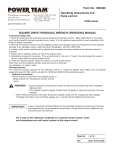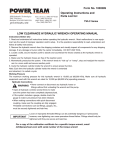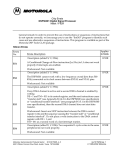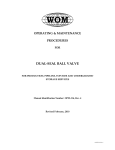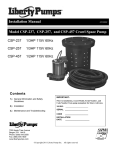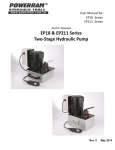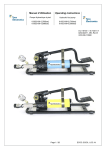Download SQUARE DRIVE HYDRAULIC WRENCH - Gee
Transcript
Operating Instructions and Parts List for: TWSD Series SQUARE DRIVE HYDRAULIC WRENCH OPERATING MANUAL Instructions Before Use 1. Read and understand all instructions before operating the hydraulic wrench. Most malfunctions in new equipment are the result of improper operation and/or setup. It is the operators responsibility to read, understand, and follow all safety instructions. 2. Remove the hydraulic wrench from the shipping container and visually inspect all components for any shipping damage. If any damage is found, notify the carrier immediately. DO NOT USE TOOL. 3. Locate a solid, secure reaction point to absorb and counteract the forces created as the hydraulic wrench is operated. 4. Make sure the hydraulic hoses are free of the reaction point. 5. Momentarily pressurize the system. If the wrench tends to “ride up” or “creep”, stop and readjust the reaction arm to a more solid and secure reaction point. 6. Cycle the hydraulic cylinder inside the wrench to ensure proper function. Note: Each time the hydraulic cylinder inside the wrench is extended and retracted, it is called a cycle. Working Pressure The maximum working pressure for this hydraulic wrench is 10,000 psi (68,900 kPa). Make sure all hydraulic equipment used with this wrench are rated for 10,000 psi (68,900 kPa) operating pressure. Hydraulic Connections • Never connect or disconnect any hydraulic hoses or fittings without first unloading the wrench and the pump. WARNING • Open all hydraulic controls several times to make sure the system has been completely depressurized. • If the system includes a gauge, double check the gauge to make sure pressure has been released.• When making connections with quick disconnect coupling, make sure the coupling are fully engaged. Threaded connections such as fittings, gauges, etc., must be securely tightened and leak-free. Loose or improperly threaded fittings can be potentially dangerous if pressurized, however, over-tightening can cause premature thread failure. Fittings should only be tightened until they are secure and leak-free. IMPORTANT Sheet No. 1 of 12 Rev Date: 16 July 2007 Operating Instructions This is the safety alert symbol. It is used to alert you to potential personal injury hazards. Obey all safety messages that follow this symbol to avoid possible injury or death DANGER Denotes an imminently hazardous situation which, if not avoided, will result in death or serious injury. WARNING Denotes a potentially hazardous situation which, if not avoided, could result in death or serious injury. CAUTION Denotes a potentially hazardous situation which, if not avoided, may result in minor or moderate injury. CAUTION Caution used without the safety alert symbol indicates a potentially hazardous situation which, if not avoided, may result in property damage. IMPORTANT Denotes an operating or service procedure or condition considered essential for expedient and efficient operation and service. WARNING To help prevent personal injury, • Always wear eye protection whenever operating hydraulic equipment. • Always wear hearing protection as required. • Operation, repair, or maintenance of hydraulic equipment should be performed by a qualified person who understands the proper function of hydraulic equipment per local directives and standards. • To prevent personal injury, use common sense. Do not use any power equipment under the influence of any mood altering substances. • Never place your hands or other body parts near a hydraulic fluid leak. Never use your hands or other body parts to check for a possible leak. High pressure fluid can be injected under your skin causing serious injury and/or infection. • Electric motors may spark, causing an explosion when flammable materials are present. Do not operate in an explosive atmosphere or in the presence of conductive liquids. Use an air motor or hand pump instead. • To prevent electrical shock, make sure the pump is properly grounded and the proper voltage is being used. • To prevent personal injury, the WARNING remote control must only be used by the wrench operator. WARNING Read and understand this material before operating or servicing this equipment. Failure to understand how to safely operate this tool could result in a accident causing serious injury or death. • Only qualified operators should install, operate, adjust, maintain, clean, repair, or transport this machinery. • Inspect tool before use. Replace any worn or damaged parts. Failure to observe these warnings can result in severe injury or death. • Keep work area clean and well lit. • When not in use, wrenches and accessories should be properly stored to avoid deterioration. • Do not use hydraulic hoses, pump power, or remote control cords as means of moving the equipment. • Make sure all hydraulic connections are securely attached. Verify that the hydraulic hoses are not kinked. • Remain clear of the reaction arm during operation. Never put body parts between the reaction arm and the reaction point. • Always use top quality impact sockets in good condition and remain clear of sockets during operation because hidden flaws could cause breakage. CAUTION To prevent wrench damage, always use the properly sized tool and accessories. Do not use a wrench for anything other than the intended purpose. Operating Instructions MULTI AXIS SWIVEL MANIFOLD SQUARE DRIVE RELEASE BUTTON HYDRAULIC COUPLINGS REACTION ARM RELEASE BUTTON SQUARE DRIVE REACTION ARM REACTION ARM PROTECTION PAD Safety A) Never exceed the torque wrench maximum working pressure (Advance 689 Bar / 10,000 psi, Retract 69 Bar / 1000 psi) B) Keep hands and fingers clear of the torque wrench head and reaction arm area, before and during operation. Fingers could be inadvertently trapped if care is not taken. C) Keep other personnel clear of the working area and only allow trained personnel to use the equipment. Ideally rope off the working area. D) Prior to operation, ensure that all hoses, sockets and ancillary equipment is undamaged and fit for purpose. Ensure that all torque wrench components (i.e. square drive, reaction arm, etc.) are properly attached and secure. Ensure that the square drive retainer button is properly located. E) Do not strike any of the components, including the socket, with a hammer in order to shock the nut free. F) Check that reaction structures are strong and rigid enough to accept the torque tool reaction forces. Do not use wedges, packing pieces, etc as a temporary reaction. G) Take care when handling equipment. Quick connect couplings are especially susceptible to knocks and damage and therefore care must be taken. Note that damaged couplings are difficult to connect. Do not force couplings. H) Do not retighten any equipment whilst under pressure. I) Some torque wrenches (and sockets) weigh in excess of 20Kg, therefore ensure that lifting equipment is available and used. Sheet No. 3 of 12 Rev Date: 16 July 2007 Operating Instructions J) Do not strike, misuse or abuse any of the equipment. If any abuse or misuse of the equipment is evident, the warranty shall be invalid and the Manufacturer shall not be responsible for any injuries or failures as a result. K) In some instances it may be necessary for the Operator to support the torque wrench whilst it is tightening, i.e. upside down applications. If the torque tool cannot be strapped into position using ropes, etc, then the operator must take the utmost care to avoid pinch points. L) Never use the torque wrench with just one hose connected to the Advance port (port ‘A’). This will cause a pressure intensification within the retract chamber possibly leading to tool damage. Always ensure that both hoses are connected. OPERATION CAUTION For top performance, frequently inspect wrench, pump, and accessories for visual damage Always follow instructions for proper wrench and pump maintenance. Do not use other equipment to increase the capability (for example, hammering on socket wrench). General Each hydraulic wrench is supplied completely assembled and ready for use. A hydraulic pump is required to provide the speed and pressure that makes the hydraulic wrench system efficient and accurate. Connecting the System The hydraulic wrench head and power pack are connected by a 10,000 psi (68,900 kPa) single-line hose assembly. Each end of the hose will have one female connector. NOTE: DO NOT switch the hose connector from female to male. It is necessary for the hose to have a female connector to engage the male connecter on the hydraulic wrench. Electrical Connections Make sure the power supply is compatible with the requirements of the electric pump motor. Minimize the length of extension cords and be sure they are of adequate gauge and grounded. Air Connections Make sure the air flow rating is adequate and compatible prior to pressuring the pump. Make sure all connections are tight and leak-free Changing the Drive Direction In order to change drive direction, press and hold the drive release button, then pull out the square drive. The square drive, retainer cap and button assembly are now free from the torque wrench, take care not to lose them To re-install, insert the square drive into the tool head (the square drive won’t enter until the splines are aligned) and replace the retainer cap assembly. As a check, pull the square drive to ensure that it is locked in position. Using the Reaction Arm The TWSD torque wrench features a 360° adjustable reaction arm. Although the reaction arm can be placed in a multitude of positions, always try to use the torque tool with the reaction arm positioned parallel to the socket (i.e. 90° to the torque tool body). See Fig. 2 below Sheet No. 4 of 12 Rev Date: 16 July 2007 Operating Instructions Reaction Point Safety Extreme care must be taken when selecting appropriate reaction points and the following must be borne in mind at all times. SOCKET REACTION ARM PARALLEL TO SOCKET, A ND BUTTED FIRMLY AGAINST FLANGE NUT Fig 2. CORRECT POSITIONING OF REACTION ARM • The reaction structure must be rigid enough to accommodate the reaction forces from the torque wrench, which can be extreme at times. Carefully assess the reaction points for suitability before applying the torque tool. If in doubt, contact the torque wrench supplier for advice. • Ensure that the reaction structure is suitably shaped to accommodate the reaction arm, Tapered surfaces are generally unsuitable as the torque wrench tends to ‘ride up’ the taper, causing adverse tool loads. Flat surfaces are most preferred. • If in any doubt over the suitability of the reaction point, contact your torque wrench Supplier as various reaction accessories are available which may prove more suitable. • Don’t improvise. Packing pieces, spacers, etc. are dangerous and must never be used as a makeshift reaction point. Sheet No. 5 of 12 Rev Date: 16 July 2007 Operating Instructions Use of Sockets Use high quality, industrial impact sockets at all times. Ensure that sockets are rated to accept the full torque output of the torque wrench that they are to be used with. Regularly check the socket for cracks and flaws, if any sign of damage is evident, discard it immediately as a damaged socket breaking under load could cause equipment damage or Operator injury. Long reach or deep sockets are not recommended for use with hydraulic torque tools, as they tend to make the wrench and socket unstable. However, some applications demand the use of long reach sockets, therefore it is imperative that support is provided for both the socket and reaction facility. The same applies to socket accessories such as extension bars, knuckle joints (not recommended), etc. Setting Torque Setting Up Prior to Operation Setting up the equipment only takes a few minutes and some simple checks during set up will aid in the success of the torquing operation. • Obtain the torque value that is to be used for the tightening operation. • Ensure that the bolt threads, nut threads and nut to flange contact faces are liberally coated with anti-seize lubricant of known friction co-efficient. Ensure that the lubricant friction co-efficient matches that which has been used to derive the torque value. • Make sure that the torque wrench is suitable to deliver the required torque. Should the torque value exceed 80% of the torque wrench output, consider using a higher capacity torque wrench. • Use the ‘Pressure – Torque Conversion Chart’ for the particular torque wrench to be used (supplied with the torque wrench) to obtain the required pump pressure. • Make sure that the socket to be used is of the correct type and size. A poor fitting or oversize socket will damage nuts, induce inaccurate bolt loads and possible cause operator injury. • Place the proper size impact socket on the square drive and secure it properly with the locking ring and pin. Make sure the square drive is fully engaged into the socket. • Place the wrench and socket on the nut. Make sure the socket is fully engaged on the nut. • Make sure the reaction arm is placed firmly against a stationary object such as an adjacent nut, flange, equipment housing, etc. NOTE: When positioning the wrench, make sure the hose connection will not hit any stationary object. This may result in snapping a hose connection or breaking the coupler connection. • Apply momentary pressure to the system to ensure proper wrench placement. Setting Torque Electric and Air Pumps 1. Make sure the system is fully connected and the proper power supply is available. 2. Use the Pressure/Torque conversion chart supplied with the wrench to find the required pressure setting. NOTE: On electric or air pumps, this pressure is set on the pump. 3. Turn on the pump. 4. Press and hold the remote control button. Sheet No. 6 of 12 5. Check the pressure on the gauge. 6. Increase or decrease pressure as required by loosening the locking ring on Rev Date: 16 July 2007 Operating Instructions the pressure regulator valve and turning the thumb screw. NOTE: Turn the thumb screw clockwise to increase pressure and counterclockwise to decrease pressure. When decreasing pressure, it is necessary to turn the thumb screw to a pressure setting below what is desired and gradually increase pressure to the desired level. 7. Once the desired pressure is stabilized, release the remote control button and tighten the locking ring. 8. Prior to tightening a nut, press the remote control button and confirm the correct pressure has been set. Manual Pumps Find the required torque in the Pressure/Torque conversion chart and read across the chart to the corresponding pressure. Operating the Wrench Electric or Air Pump Tightening 1. Connect the torque wrench to the pump unit. Ensure that the couplings are fully screwed together as they are self-sealing and will restrict oil flow if not fully connected. NOTE : TWSD torque wrenches are equipped with a pressure release valve built into the Multi-Axis Swivel Manifold to protect against retract pressure intensification should the retract port hydraulic coupling not be fully connected, or become loose during use. If an intensification occurs, the valve will bleed hydraulic oil externally from the manifold yoke. Note that oil bleeding from the swivel manifold is not a sign of seal leakage. 2. Prior to applying the torque wrench (and socket) to the application, the pump output pressure must be pre-set to relieve at the pressure obtained from the ‘Pressure – Torque Conversion Chart’. This can be done with the torque wrench connected to the pump and resting on the floor or bench. Applying advance pressure to the torque wrench will extend the piston until it reaches the end of its stroke whereby the pump pressure will build. Holding the wrench at the end of its stroke will allow the pump pressure to be adjusted. Retract the torque wrench piston and advance again making sure that the pump relieves at the desired pressure setting. Blanking the pump outlets using blank couplings can also be done to carry out the pump pressure setting. NOTE : Allow time for the wrench to retract. If another advance stroke is made before the torque wrench has fully retracted, the ratchet mechanism may not engage correctly, causing it to jump a ratchet tooth (probably damaging the ratchet). Before applying another advance stroke, make sure that the pump is idling at 69 Bar (1000psi), which indicates full retraction. 3. Apply the torque wrench and socket to the nut to be tightened, ensuring that the reaction arm butts firmly and squarely against the selected reaction point. 4. Start the pump and advance the torque wrench. As the wrench strokes forward the reaction arm will press against the reaction point and the nut / socket will rotate. When the torque wrench reaches the end of its stroke, the pump pressure will build rapidly. Retract the torque wrench (the wrench ratchet mechanism will be heard clicking as it retracts), and apply another forward stroke 5. Several forward strokes are made until the nut ceases to rotate during the stroke, (known as stalling), but bear in mind that nut rotation will always cease at the end of the wrench stroke and must not be confused with the wrench stalling. WHEN THE WRENCH STALLS, APPLY ANOTHER FORWARD STROKE AND OBSERVE THE PUMP PRESSURE GAUGE, WHICH SHOULD READ THE DESIRED PRE-SET PRESSURE. 6. Retract the torque wrench, stop the pump unit, and remove from the nut Sheet No. 7 of 12 Rev Date: 16 July 2007 Operating Instructions Loosening Bolts 1. Connect the torque wrench to the pump unit. Ensure that the couplings are fully screwed together as they are self-sealing and will restrict oil flow if not fully connected. 2. Prior to applying the torque wrench (and socket) to the application, the pump output pressure must be pre-set to deliver the maximum pressure of 690 Bar (10,000psi). This can be done with the torque wrench connected to the pump and resting on the floor or bench. Applying advance pressure to the torque wrench will extend the piston until it reaches the end of its stroke whereby the pump pressure will build. Holding the wrench at the end of its stroke will allow the pump pressure to be adjusted. Retract the torque wrench piston and advance again making sure that the pump delivers full pressure. Blanking the pump outlets using blank couplings can also be done to carry out the pump pressure setting. 3. Apply the torque wrench and socket to the nut to be loosened, ensuring that the reaction arm butts firmly and squarely against the selected reaction point. 4. Start the pump and advance the torque wrench. As the wrench strokes forward the reaction arm will press against the reaction point. As the pump pressure builds (and thus torque applied to the nut), the nut will break free. Once the nut has been released, remove the nut by hand if loose enough, or alternatively use an impact wrench, it is not recommended to use the torque wrench. NOTE : Should maximum pump pressure be reached, and the nut has still not broken free, use a higher capacity torque tool (providing that the nut/bolt material will accept the higher torques without damage). Do not, under any circumstances, strike the socket or torque wrench in an attempt to ‘shock’ the nut free. 5. Retract the torque wrench, stop the pump unit, and remove from the nut. Notes on Loosening Bolts Loosening of bolts using torque tools can be unpredictable and often unsuccessful, especially if the nuts and bolts are severely corroded. However, some measures can be carried out to increase the success rate of nut breakout. • In general, loosening mildly rusted bolts requires up to twice the make up torque to release the nut. Heavily corroded bolts may take up to three times the make up torque. Ensure that the bolt and nut material is strong enough to accept these higher torques. • Remove surface rust and scale using a wire brush. Apply releasing oil to the nut, bolt and bearing face, and allow time for the release oil to soak in and penetrate. • Only use the torque wrench to break the nut free. Using the torque tool to wind the nut from the bolt can induce high torsion and reaction forces, therefore it is better to use and impact wrench to completely remove the nut. • Never strike the socket or torque wrench in an attempt to ‘shock’ the nut free. This will cause damage to the socket and torque wrench, and could result in operator injury. Evidence of torque wrench abuse will invalidate the Manufacturer’s Warranty. Manual Pumps 1. To operate the hydraulic wrench with a hand pump, make sure the pump is rated at 10,000 psi (68,900 kPa) maximum pressure. 2. Connect the hand pump to the hydraulic wrench with a single-line hose assembly. Sheet No. 8 of 12 Rev Date: 16 July 2007 Operating Instructions Tightening 1. 2. 3. 4. Determine the required pressure. Make sure the hydraulic wrench and the reaction arm are in the tightening mode. Pump the hand pump to advance the hydraulic cylinder inside the wrench until the socket stops turning. Release the pump pressure. The hydraulic cylinder inside the wrench will automatically retract and an audible “click” will be heard. This completes one cycle. Loosening 1. Make sure the hydraulic wrench and the reaction arm are on the loosening mode. 2. Pump the hand pump to advance the hydraulic cylinder inside the wrench. As pressure builds, the bolt will begin to loosen. 3. Stop pumping when the socket stops turning. 4. Release the pump pressure. The hydraulic cylinder inside the wrench will automatically retract and an audible “click” will be heard. This completes one cycle. 5. Continue to loosen the nut with successive cycles until the nut can be removed by hand. 6. Proceed to the next nut. 7. General Torquing Procedure General Torquing Procedure The following procedure is for use with TWSD torque wrenches and outlines the basic steps in order to carry out the torque tightening of a flanged joint. It is important that personal protective clothing (gloves, footwear, safety helmet, eye protection) is worn at all times not only by the Operator, but also by any personnel within the work area. The torquing procedure is compiled around using a single torque wrench, the object of the procedure being to accurately achieve a pre-determined residual bolt stress. SAFETY: Prior to commencement of bolt torquing ensure that: • All necessary safety precautions have been carried out • Personnel involved in torquing are competent and fully trained in the use of hydraulic torque tools and tightening techniques. • The procedure and data to be used is authorized by a responsible Engineer. • The joints / pipework to be worked on are not ‘live’. Joints must be at zero pressure and free from hazardous substances. • Torque value selected must be based upon the lubricant applied. STAGE 1 Number each bolt consecutively, 1, 2, 3 etc STAGE 2 Using torque wrenches (if necessary), square up the flanged joint. STAGE 3 Working in a diametrical sequence (tightening opposite bolts) apply the minimum torque available. i.e. set pump to lowest possible output (1000psi). Note the sequence used. STAGE 4 Repeating the above noted tightening sequence, apply approximately 25% of the torque value specified in the torque data. STAGE 5 Using the same noted tightening sequence, apply approximately 50% Sheet No. of the torque value specified in the torque data. Rev 9 of 12 Date: 16 July 2007 Operating Instructions STAGE 6 Using the same noted tightening sequence, apply the full torque value specified in the torque data. STAGE 7 Working in a clockwise (or anti-clockwise) direction, make a final pass around the flange, tightening each bolt to the full torque value specified in the torque data. STAGE 8 Following completion of Stage 7, using a hammer, “ring” each nut to ensure that each bolt has been correctly loaded and that no slack bolts remain. Maintenance and Preventative Maintenance Inspect hoses and fittings before every use. Connections must be clean and properly connected before each use. Replace worn or damaged fittings. Keep tools clean and protected from damage. Post-Use Maintenance In order to keep the TWSD torque wrench in good working condition, it is recommended that simple post-use maintenance be carried following each period of use. TWSD Torque wrench 1. Wipe away any debris that may have accumulated, particularly around the square drive area, reaction arm splines and hydraulic couplings. 2. Check the following areas : Hydraulic Couplings for signs of damage - replace if evident. Swivel Manifold. Ensure the spiral retaining ring is present and fitted correctly. Ensure the Guard is present and securely attached. Replace / re-attach as necessary. Remove the square drive from the torque wrench and inspect for damage, cracks, etc. Re-lubricate the bearing journals using ‘Lithium Complex EP Grease’ and replace the square drive. Note that that the torque tool drive components must be lubricated using the specified product only. Using alternative lubricants will affect the torque tool output and possibly lead to premature component failures. 3. It is preferable to lightly spray the torque wrench with water repellent spray (WD40), prior to placing back into storage. Hoses and Ancillaries 1. Clean and inspect each hydraulic hose and quick connect coupling. Check the entire length of the hose for cuts, abrasions and damage. Any evidence of hose damage and the entire hose must be replaced. 2. Coat each quick connect coupling with a water repellent spray (WD40). Maintenance, Servicing and Warranty In addition to post-use maintenance, and to ensure that the Product Warranty remains valid, it is recommended that routine maintenance and servicing be carried out by the Manufacturer or authorized Service Centre. Sheet No. 10 of 12 Rev Date: 16 July 2007 Operating Instructions TWSD SERIES HYDRAULIC TORQUE WRENCH PRESSURE - TORQUE CONVERSION CHART Sheet No. 11 of 12 Rev Date: 16 July 2007 Operating Instructions Fault Cylinder will not advance. Cylinder will not retract. Torque wrench operates backwards Possible Cause 1. 2. 3. 4. Coupling not fully mated Cylinder seal leakage Pump unit Faulty coupling Remedy 1. 2. 3. 4. Check coupling Replace seal Check pump unit Replace coupling 1. Reversed couplings. 1. Check pump, hose and torque wrench for cross connection Pressure will not build 1. Cylinder Seal leakage 2. Swivel Seal leakage 3. Defective pump unit 1. Change seals 2. Change seals 3. Check pump unitPa Pressure builds, but wrench does not move 1. Hose restriction 2. Coupling not fully assembled 1. Change hose 2. Fully tighten coupling Slow torque wrench operation 1. Hose restriction 2. Coupling not fully assembled 3. Pump flow rate too small 1. Change hose 2. Fully tighten coupling 3. Use higher flow pump Erratic or slow retraction speed 1. Hose restriction 2. Coupling not fully assembled 1. Change hose 2. Fully tighten coupling Torque wrench does not ratchet 1. Broken drive shoe 2. Jammed drive shoe 3. Damaged ratchet 1. Replace drive shoe 2. Check drive shoe and spring 3. Check / replace ratchet Ratchet jumps whilst driving 1. 2. 3. 4. 1. 2. 3. 4. Difficulty in hose connection 1. Pressure within hose 2. Damaged coupling Worn / damaged ratchet Worn / damaged drive shoe Wrench incorrectly retracted Weak / snapped drive shoe spring. Replace ratchet and drive shoe Replace ratchet and drive shoe Allow time to fully retract. Replace springs 1. Vent hose 2. Replace coupling Sheet No. 12 of 12 Rev Date: 16 July 2007












